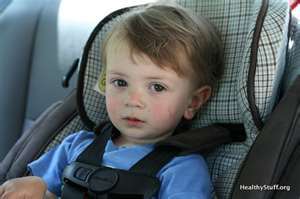Awareness of Children Dying in Hot Cars Rises Dramatically Over Warm Weather Months, New Survey Finds
 |
WASHINGTON -- Aug. 28, 2014: A new national survey released today shows that public awareness of the dangers of leaving young children alone in hot vehicles has risen dramatically -- by nearly 25 percent -- since the start of the summer.
The survey, conducted online from August 8-13 by Public Opinion Strategies, found that 85 percent of the respondents had seen, read, or heard "a lot" or "some" about children suffering from heatstroke in vehicles, compared to 69 percent in a survey released by Safe Kids Worldwide in April. Significantly, the percentage of those seeing, reading, and hearing "a lot" jumped from 20 percent to 37 percent, while those seeing, reading, and hearing "nothing at all" dropped from 10 percent to 5 percent.
Most of the 95 percent who have some awareness of the issue recall stories in the news media about parents who left children in the car while shopping, or while going to bars, beauty salons or casinos. This summer, there has been a great deal of attention about a Georgia father who was charged with homicide for leaving his child in a hot car, with some recalling several details about the case.
The survey also showed that there was also a substantial increase in awareness for parents and those who transport young children, from 72 percent to 85 percent. In this category, 38 percent now have a high level of knowledge about the child safety issue.
The survey was commissioned by the Alliance of Automobile Manufacturers.
Since record keeping began in 1998, at least 629 young children, most three years of age and younger, have died in hot cars, primarily when left in the vehicle by a parent or caregiver or by being trapped after gaining access to an unlocked car.
So far this year, there have been 23 child deaths in hot cars. By this time in 2013, one of the worst years on record, 32 children had died. The annual average since 1998 is 38.
"The increased level of awareness is very encouraging," said meteorologist Jan Null of San Jose State University, who has helped raise awareness of these tragedies and maintains the most complete data on the subject. "Media attention to high profile incidents this year and enhanced prevention campaigns by the National Highway Traffic Safety Administration, Safe Kids Worldwide and others have been effective in educating the public, which certainly has saved children's lives. We must continue these efforts to translate the heightened awareness into safer behavior by caregivers and more attention by bystanders who see children in danger and inform public safety officials."
"Many people are shocked to learn that the temperature inside of a car can rise 20 degrees in 10 minutes. And cracking the window doesn't help," said Kate Carr, president and CEO of Safe Kids Worldwide. "We know that the best way to protect children from this very preventable tragedy is by raising awareness and educating parents, caregivers and bystanders. This new research shows that we are making progress, which is saving lives. We're calling on everyone to stay vigilant, keep spreading the word, and remember to never leave a child alone in a car and to look before you lock."
The survey further found that:
Increased awareness was primarily among older, higher-educated and higher-income groups (so called "high information" groups), such as men 55 and older (up 32 percent), and suburban and college-educated women (up 28 percent). Sixty-two percent of parents and transporters of children six years old and younger said that they are now less likely to let a child stay in a parked, locked car because of what they have seen, read, or heard about child heatstroke in vehicles. Thirty percent of these parents and transporters say they are neither more nor less likely to leave their children in a locked car, because they never would have done so in the first place. With regard to bystanders, the survey found that 74 percent of adults said they are more likely to intervene if they see a child in a hot vehicle based on what they have seen, read, or heard recently. Groups which are most represented in this category -- many of them classified as "lower information" -- include urban women (87 percent more likely to take action), African Americans (87 percent), women with less than a college education and women with income under $60,000 (both 86 percent). The actions this group would take to help children in vehicles closely track with the April survey (call the police/911; attempt to rescue the child by breaking in to the car; report the situation to the store manager/security, etc.) but with a slight increase in those saying they would break into the vehicle to rescue the child. Parents, caregivers and bystanders are encouraged to help reduce the number of heatstroke deaths by remembering to ACT.
A: Avoid heatstroke-related injury and death by never leaving your child alone in a car, not even for a minute. And make sure to keep your car locked when you're not in it so kids don't get in on their own. C: Create reminders by putting something on the backseat of your car next to your child such as a briefcase, a purse or a cell phone that is needed at your final destination. This is especially important if you're not following your normal routine. T: Take action. If you see a child alone in a car, call 911. Emergency personnel want you to call. They are trained to respond to these situations. One call could save a life. The survey results will be available at It's That Serious .


